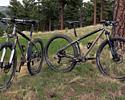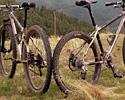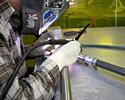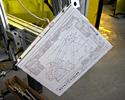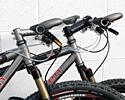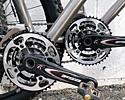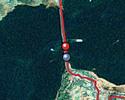
Recently on Cyclingnews.com |
Tech Feature: 26in vs. 29in wheelsGetting to the bottom of the MTB wheel size brouhahaPart one: the groundworkTwo-niner this, 29-inch that… what's the deal with those big wheels, anyway? Once dismissed as a passing fad, the 29-inch-wheel "revolution" has taken a firm hold on the mountain bike world. Even the geometrically challenged can see that the wheels are substantially bigger than the 26-inch standard, but what exactly is it about these giant hoops that has everyone all up in arms? James Huang takes an in-depth look at the issue through an engineering lens to figure it out once and for all in Part One of this two-part feature.
What's the best wheel size for an off-road bike? It's not a new question. In the 1980s a couple of manufacturers - notably Cannondale - offered mountain bikes with 24-inch rear wheels, and in the 1990s GT briefly dabbled with an all-purpose, intermediate size called 700D. More recently, some downhillers have used 24-inch wheels to allow fatter tyres in more-or-less conventional frames. But the biggest controversy has come about as a vocal group of bike makers and riders have adopted bikes with 700C-sized rims, and two inch tyres, a combination that has become known as a "29-inch" wheel for the overall diameter of the combination. Two-niners, as they are also known, are currently among the hot topics in the MTB world with riders of all disciplines extolling their claimed virtues over the well-established 26-inch standard. According to two-niner proponents, the larger wheels carry more speed, are better able to roll over obstacles, and provide better cornering and climbing traction in spite of their greater mass. In spite of the heated debate over the benefits, new two-niners are popping up in all corners of the industry, particularly among the smaller niche builders as witnessed at the recent North American Handmade Bicycle Show. Revolution or not, do 29-inch wheels actually offer any real tangible advantages? Dave Harris, an ultra-endurance mountain bike racer on the Team HealthFX squad, recently conducted his own quasi-scientific study to answer the question for himself. In contrast to what many believe subjectively (and often passionately), Harris found that his two-niner required more power to propel and, more importantly, produced slightly slower lap times as compared to his 26-inch-equipped rig. Somewhat expectedly, a wealth of industry and rider backlash ensued, and perhaps for good reason. Harris admits that his 'study' didn't exactly precisely follow the tenets of scientific method; it was obvious that the bikes in question were not directly comparable. As one reader put it, "…the difference in frame designs seems like a huge uncontrolled variable", and Jason Bouchard, general manager for Salsa Cycles, added, "…you need to minimize the differences between the two test subjects… Simply stating the bikes weighed about the same and the tires were the same brand and model isn't enough." Given the growing popularity of the 29-inch wheel format and the seemingly unending amount of debate on the subject, Harris' study was a worthwhile endeavor but an admittedly imperfect one. Ask and ye shall receiveThe core flaw in Harris' wheel size investigation (and most others, quite frankly) was that there were far too many variables involved in order to draw any valid conclusions. In response, Cyclingnews has assembled a very special test pair of mountain bikes in order to examine the effects of wheel size where the only primary variable is the size of the wheels. We worked closely with the specialists at Seven Cycles to obtain a pair of Seven's premier carbon and titanium IMX hardtail frames. Seven's unique talents were tapped to normalize the ride qualities of the two frames by varying the titanium tubing stock as well as the carbon fiber layups, and the handling characteristics were matched as closely as possible. Of equal importance was the fit of the two IMXs and this was calibrated down to the last millimeter relative not only to the rider, but also to the ground. To that effect, critical dimensions such as cockpit length, saddle height and setback, handlebar height and sweep, and even bottom bracket height are 100 percent identical between our decidedly high-zoot test pair. In addition, the help of a multitude of other companies was enlisted to outfit the two bikes with matching specifications save for those are dependent on wheel size. Component setup between our two IMXs mirrored each other as well, including key parameters such as tire pressure, fork pressure and damper settings, as well as minutiae such as grip angle, shifter and brake lever positions, and even type and amount of chain lubricant (see sidebar for more detailed information on the bikes). Big deal… now what?So what are we going to do with them? Well, ride them a lot, of course! Ok, well that's only partially true. Over the next few weeks, the bikes will be ridden as often as possible back-to-back on a select group of short courses with varying terrain that we believe will highlight differences between the two wheel formats. We won't be recording power outputs (unfortunately, Powertap does not have its disc brake-compatible hub available yet), but heart rates will be confined to a narrowly-defined range to keep things reasonably consistent between runs. When coupled with the large sample sizes (I did say 'ride them a lot', didn't I?), overall power outputs between the two bikes should be reasonably normalized so as to minimize the influence of a 'good day' or 'bad day' on the overall data. Speaking of data, we will be collaborating with the folks at Garmin and MotionBased for both data acquisition and post-acquisition analysis. Rather than construct artificial test conditions to simplify data analysis, Garmin's Edge 305 computers will be used to collect real-world and real-time data during each lap. Motionbased's software will not only allow us to simultaneously replay various laps (overlaid on a variety of satellite maps, no less) but its section-by-section data analysis will also provide some hard numbers as to each bike's performance in defined sections. Why, why, why?Cyclingnews is an equal opportunity employer, so we saw fit to include another 'w' in our list of questions. Determining which bike holds an advantage in certain situations is certainly useful information, but determining exactly why is equally, if not more, interesting. Differences in rotating weight may come into play, but the larger wheel format absolutely directly impacts such things as tire contact size and shape, angle of attack on trail obstacles, rolling resistance, as well as a host of other parameters. For the most part, we're talking basic physics here, but vehicle dynamics are occasionally less than basic. Therefore, we'll again be enlisting a bit of outside assistance here, but this time from sources both within and outside of the bicycle industry. What, did you think that wheel size is only important to mountain bikers? Think again. No blindfolds requiredWill this be a 'double-blind' test? Much as it'd be nice to do for the sake of adhering to scientific method, the unfortunate answer is no. After all, conducting the test in such a fashion would require by definition that the tester have no knowledge as to which bike is being ridden at the time. As shrouding the entire bicycle in order to conceal the wheel sizes is not exactly practical (and blindfolding riders during testing just plain silly), our aforementioned test protocols will have to suffice. When all is said and done, we'll hopefully not only have some sound conclusions but also some concrete reasoning as to why the different wheel sizes perform as they do. Will everyone agree? Maybe not, but math is math, and assuming our approach, assumptions, and boundary conditions are correct, numbers are hard to argue with. Initial impressionsOur final judgments will come at a later date only after we've compiled and fully analyzed the data. At this point, though, we're sufficiently through the 'acclimatization' phase such that we can offer up some early feedback on how each bike seems to perform. From a purely subjective standpoint, there are a number of immediately perceptible differences between our two bikes. On the trail, the two-niner simply feels bigger and heavier. The wheelbase is noticeably longer, the wheels feel like they require more energy to get going, and the overall weight distribution of the bike just feels a bit odd. In terms of handling, the two-niner requires a bit more effort to initiate turns, and just feels a bit sluggish. Conversely, the 26-inch bike is markedly more nimble and seems to require less energy to change direction, plus the lighter wheels feel faster when accelerating be it in a sprinting situation or during a climb. On the flipside, however, that same propensity to change direction in the 26-inch bike also makes it a bit twitchier in corners, particularly if the trail conditions vary midstream. While the two-niner requires more effort to initiate the turn, it's also more stable through that corner and holds a line better. Also, although the two-niner feels oddly big, it also feels quite stable and is definitely more capable of rolling over trail obstacles. Will our numbers support these initial opinions? Time will tell, and we're excited to find out.
About the bikes and the specFramesetsWe specifically chose hardtails in order to eliminate any influence of rear suspension, and while production frames were an option, fully custom frames were the natural choice here in order to limit the variability between the two frames as much as possible. On the subject of head tubes angles… astute readers will note that, given identical head tube angles and fork offsets, the two-niner will have an inherent handling disadvantage due to the increased trail measurement relative to the 26-inch version. To that, we say that you are entirely correct. For the first stage of this experiment, we will be using two Magic IMV forks from White Brothers. Both of the forks come complete with White Brothers' new Intelligent Magnetic Valve platform damper with 80mm of travel and both forks have identical offsets at 38mm each. While this will invariably produce somewhat slower handling in the two-niner, this is still how a lot of two-niners are done, as well as how most riders are currently experiencing 29-inch wheels, so we wanted to make sure we were on the same page here. More importantly, running identical angles on a two-niner is, according to two-niner proponents, one of the most commonly made mistakes in constructing two-niner frames, so we wanted to make sure we had all of our bases covered. For the second stage, however, we'll be using two rigid carbon fiber forks supplied by the singlespeed specialists at On-One. In this case, the offsets of the two forks will be adjusted to yield near-identical trail figures. This will not only remove the haze of suspension entirely from our experiment, but will also allow us to truly evaluate handling differences between our two Seven IMXs as well as the effects of wheel size on other characteristics such as bump absorption. Yes, I know that rigid forks and big sharp rocks don't necessarily go together, but my wrists are still relatively healthy (ask me about them when I'm done with this… sheesh, the lengths we go to for you guys!). Our Seven IMX 26-inch frame weighed in at 3.12lbs/1.42kg, with the two-niner version adding only 0.27lbs/0.12kg. Similarly, our White Brothers Magic 80 IMV 26-inch fork tips the scales at 3.71lbs/1.69kg, and the two-niner version is a bit heaver at 3.98lbs/1.80kg. WheelsBontrager supplied us with two pairs of Race Lite Disc wheels. Both use identical DT Swiss-built disc-compatible hubs, spoke gauges, and lacing patterns, but obviously, the rims are a required difference with one set being sized for standard 26-inch tires and the other for 29-inch rubber. Bontrager also supplied two pair of Jones XR tires, both with 2.25in and 2.20in casings front and rear, respectively. Our 26-inch wheels and tires were already 'Tubeless Ready', requiring just a bit of sealant to make the standard casing airtight. In the two-niner case, neither tire nor rim was factory equipped to be tubeless, but they were converted using rim strips and sealant from NoTubes. This conversion served a couple of purposes: for one, it minimizes the weight penalty of the two-niner wheels and also minimizes headaches to yours truly resulting from the prickly goatheads that frequent my new Rocky Mountain stomping grounds. Simply adding tubes to our 26-inch wheels would also have served to equalize the weight differences somewhat but also would have created a greater differential in rolling resistance than already exists due to the varying wheel diameters. When fully assembled (with rotors and cassettes), our 26-inch wheels come in at 8.52lbs/3.87kg. As expected, the two-niner wheels are heavier at 9.10lbs/4.13kg. All of the increased weight can be found at the rim and tire (and spokes, to a lesser degree). DrivetrainWe debated whether or not to adjust the drivetrains on the two bikes to yield identical rollouts. While this would have been nice in theory, sufficiently low gears do not exist to adjust the two-niner down to match those of the 26-inch bike, and the fitness of the primary tester (er, that would be me) dictated that the gear ratios of either bike certainly not be made any harder. More importantly, however, the gearing is, again, an accurate representation of how both bikes would actually be used by the typical rider. Crank Brothers provided one pair of Candy 4ti pedals as well as a pair of Candy Ti pedals for our test. Ok, you got me here. The pedals are not identical, but they function identically and the weight difference is sufficiently small that it shouldn't influence the supposedly overriding effect of the different wheel sizes. The shorter spindles of the 4ti, however, will make for some interesting discussion on the effects of Q-factor to be done at a later date. For the purposes of this test, though, pedals will be swapped periodically to keep things even.
|
|||||||||||||||||||||||||||||||||||||||||||||||||||||||||||||||||||||||||||||||||||||||||||||||||||||||||||||||||||||||||||||||


